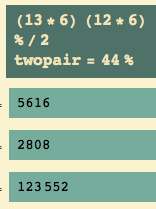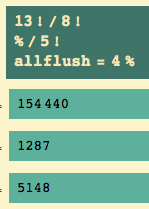Poker Hands – 5 card draw
introduction
Draw poker is played with a standard deck of 52 cards: 13 ranks (Ace through 10, and jack, queen, king) in 4 suits. (An ace usually counts as higher than a king, unless it is being used as “1” in a run.) Each player is dealt 5 cards.
Before I ever played poker – at home – I was required to learn a mantra: one pair, two pair, three of a kind… straight, flush, full house… four of a kind, straight flush. From least to best, those are the possible winning hands. (In fact, I will distinguish a royal straight flush from other straight flushes.)
What is the probability of being dealt each one of them?
That’s the first question I’ll answer, in several parts.
After the cards have been dealt and bet on, each player may discard some and get replacements. In a second post I will ask and answer: what are the odds against improving any given hand?
There is an excellent wiki article out there. In fact, the nice way to calculate the probabilities comes from it (especially for one pair, and for nothing).
number of hands
How many 5-card poker hands are there? If order mattered, the first card could be any of the 52, the second card could be any of the remaining 51, and so on, and the fifth card could be any of the remaining 48. We could write that, of course, as
52 x 51 x 50 x 49 x 48 = 311,875,200.
Or we could write it a little more compactly as
52! / 47! = 311,875,200
where n! (n factorial) means n times n-1 times n-2 … times 2 times 1. Call that the number of possible deals.
But that’s if order matters. In a poker hand, it doesn’t matter. Well, then, given one particular set of five cards, how many ways could it have been dealt?
5!
Any one of the five cards could have been dealt first, any one of the remaining four could have been dealt second, etc.
To compute the number of possible poker hands, we take the number of possible deals and divide by 5!
hands = 52! / 47! / 5! = 2,598,960.
A more formal way to write that is to let this symbol:
\binom{52}{5}
stand for the number 52! / 47! / 5!, where we infer the 47 as 52 – 5.
Furthermore, it is often pronounced as the problem it solves. We read it as “52 choose 5” or “choose 5 out of 52”. That’s exactly what we did: we chose a subset of 5 cards out of a set of 52 cards (without replacement).
flushes and straight flushes
A flush is 5 cards of the same suit. A straight flush is simultaneously a flush and a straight, i.e. a flush with five consecutive cards: i.e. 1,2,3,4,5 up to 10,J, Q,K,A (=1); equivalently, it’s a straight all in the same suit. A straight flush 10 through ace is called a royal straight flush.
How many all-spade hands are there? This many ordered hands of one suit… this many unordered… so the number of flushes is 4 times that:
(That is, allflush = 5148.)
There is a cleaner way of stating that calculation: choose 1 suit out of 4; and choose 5 cards out of the 13 in that suit.

Yes, “4 choose 1” = 4, so I’m typing extra characters by writing
\binom{4}{1}
instead of “4”. But I like emphasizing the conceptual commonality.
Of all those flushes, exactly 4 are royal straight flushes.
royal = 4.
How many flushes are straight flushes? A straight can begin with Ace thru 10, so there are precisely 40 straight flushes, including the royal… hence 36 straight flushes excluding the royal.
str8flush = 40 – royal = 36.
Then the number of flushes which are not straights is:
flush = allflush – royal – str8flush = 5108.
straights
Any straight has 40 choices for the lowest card, and 4 for each of the remaining, so there are
allstr8 = 40*4^4 = 10240.
How many of those are straight flushes or royal straight flushes? We know that: 40 (which I saved as 4 and 36).Thus the number of straights which are not straight flushes is:
str8 = allstr8 – royal – str8flush = 10200.
Now let’s rephrase that nicely. To get the total number of straights, choose 1 out of 10 for the lowest rank in the straight, and then choose 1 out of 4 suits for each of the 5 cards.
\binom{10}{1} \binom{4}{1}^5 = 10240
four of a kind
How many 4-of-a-kind hands? 13 choices for the kind, 48 possibilities for the 5th card:
fours = 13 * 48 = 624.
Put nicely, choose 1 out of 13 for the kind, then choose 1 out of 48 for the fifth card.
\binom{13}{1} \binom{48}{1} = 624
full house
A full house is three of a kind and two of another kind.
How many full-houses? 13 choices for the triple, 12 for the pair, but there is an extra card for the triple, and two extra cards for the double.
full=(413) (612) = 3744.
It’s so much better to do it nicely: choose 1 of 13 for the value of the triple, then choose 3 out of 4 suits to fill out the triple… then choose 1 out of 12 for the value of the pair, and choose 2 out of 4 suits to get a specific pair:
\binom{13}{1} \binom{4}{3} \binom{12}{1} \binom{4}{2} = 3744
three of a kind
How many exactly 3-of-a-kind? 13 choices for the kind, but 4 ways to get each one… 412 choices for the 2nd rank and 411 choices for the 3rd rank… but order doesn’t matter, so divide by 2.
threes = (413) (412) (4*11) / 2 = 54912
Really? We know how to break this down. Choose 1 of 13 for the rank of the triple, then 3 out of 4 suits; choose 2 ranks out of 12 for the other two ranks, and for each, chose 1 of 4 suits:
\binom{13}{1} \binom{4}{3} \binom{12}{2} \binom{4}{1}^2 = 54912
two pair
The first pair is one of 13, with 6 distinct pairs and second pair is one of 12, with 6 distinct pairs… but order doesn’t matter (first pair, second pair)… and the 5th card can be any of the remaining 44.

(That is, twopair = 123,552.)
Do I believe that reasoning? Sometimes!
So let me do it cleanly. Choose two ranks out of 13 for the ranks of the two pairs… for each pair, choose 2 out of 4 suits… then pick one of the 44 cards other than these 8 to fill out the hand:
\binom{13}{2} \binom{4}{2}^2 \binom{44}{1} = 123552
The numbers are the same — but I trust the second calculation. The first one is too ad hoc.
one pair
Let me confess that I have to do this one cleanly. I get it wrong any other way.
Choose 1 out of 13 for the rank, then choose 2 out of the 4 suits; choose 3 ranks out of the remaining 12, and for each of those, choose 1 out of 4 suits:
pair =
\binom{13}{1} \binom{4}{2} \binom{12}{3} \binom{4}{1}^3 = 1,098,240
nothing
This is slick, in my opinion. It comes from the wiki link at the beginning of the post. Pick 5 ranks out of 13… but exclude the 10 straights of any one suit; for each of the chosen 5 ranks, choose 1 out of 4 suits… but exclude the 4 flushes.
none =
(\binom{13}{5}-10) \left(\binom{4}{1}^5-4\right) = 1,302,540
summary
Here’s what we’ve computed:
\left( \begin{array}{cc} \text{ONE PAIR} & 1098240 \ \text{TWO PAIR} & 123552 \ \text{THREE OF A KIND} & 54912 \ \text{STRAIGHT} & 10200 \ \text{FLUSH} & 5108 \ \text{FULL HOUSE} & 3744 \ \text{FOUR OF A KIND} & 624 \ \text{STRAIGHT FLUSH} & 36 \ \text{ROYAL STRAIGHT FLUSH} & 4 \end{array} \right)
It’s nice to see that hands do get rarer as their value rises.
Now that we have collected the number of hands… how many valuable poker hands are there? Here are the individual numbers, so add them up:

Oh, while we have that list, let’s divide every entry by the total number of hands; this is the probability of being dealt each of these poker hands:
{0.422569, 0.047539, 0.0211285, 0.00392465, 0.0019654, 0.00144058, 0.000240096, 0.0000138517, 1.53908*10^-6}
There is, for example, a 42% chance of being a dealt exactly one pair; almost 5% chance of being dealt two pair; 2% chance of being dealt three of a kind.
How many hands are of no value? We have computed
none = 1,302,540.
and what the sum of none and poker?
none + poker = 2,598,960.
And how many possible hands did we compute that there were?
hands = 2,598,960.
Good. By independently computing the valueless hands, we got a check on our computation of poker hands.
Finally, the ratio none/hands is:
none / hands = 0.501177
… so the chances of being dealt 5 useless cards is just over 50%, but not by much. You could safely remember it as 50-50, for being dealt at least a pair.
In another post, I’ll look at the odds of improving the hand you were dealt.